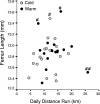Exercise mitigates the stunting effect of cold temperature on limb elongation in mice by increasing solute delivery to the growth plate
- PMID: 20930127
- PMCID: PMC3006398
- DOI: 10.1152/japplphysiol.01022.2010
Exercise mitigates the stunting effect of cold temperature on limb elongation in mice by increasing solute delivery to the growth plate
Abstract
Ambient temperature and physical activity modulate bone elongation in mammals, but mechanisms underlying this plasticity are a century-old enigma. Longitudinal bone growth occurs in cartilaginous plates, which receive nutritional support via delivery of solutes from the vasculature. We tested the hypothesis that chronic exercise and warm temperature promote bone lengthening by increasing solute delivery to the growth plate, measured in real time using in vivo multiphoton microscopy. We housed 68 weanling female mice at cold (16°C) or warm (25°C) temperatures and allowed some groups voluntary access to a running wheel. We show that exercise mitigates the stunting effect of cold temperature on limb elongation after 11 days of wheel running. All runners had significantly lengthened limbs, regardless of temperature, while nonrunning mice had shorter limbs that correlated with housing temperature. Tail length was impacted only by temperature, indicating that the exercise effect was localized to limb bones and was not a systemic endocrine reaction. In vivo multiphoton imaging of fluoresceinated tracers revealed enhanced solute delivery to tibial growth plates in wheel-running mice, measured under anesthesia at rest. There was a minimal effect of rearing temperature on solute delivery when measured at an intermediate room temperature (20°C), suggesting that a lasting increase in solute delivery is an important factor in exercise-mediated limb lengthening but may not play a role in temperature-mediated limb lengthening. These results are relevant to the study of skeletal evolution in mammals from varying environments and have the potential to fundamentally advance our understanding of bone elongation processes.
Figures





References
-
- Aardal NP, Svanes K, Egenberg KE. Effect of hypothermia and pentobarbital anaesthesia on the distribution of cardiac output in rabbits. Eur Surg Res 5: 372, 1973 - PubMed
-
- Adams EH. A comparative anthropometric study of hard labor during youth as a stimulator of physical growth of young colored women. Res Q 9: 102–108, 1938
-
- Allen JA. The influence of physical conditions in the genesis of species. Radical Rev 1: 108–140, 1877
-
- American Physiological Society Resource Book for the Design of Animal Exercise Protocols. Bethesda, MD: Am. Physiol. Soc., 2006
Publication types
MeSH terms
Grants and funding
LinkOut - more resources
Full Text Sources
Molecular Biology Databases
Miscellaneous

